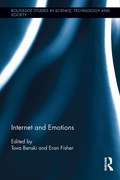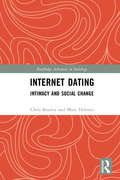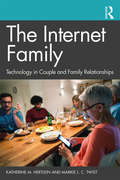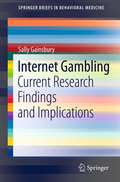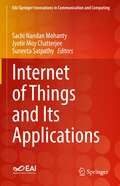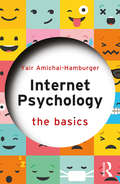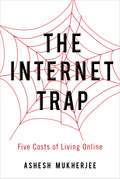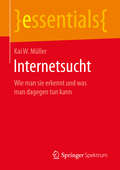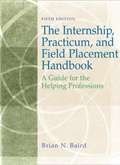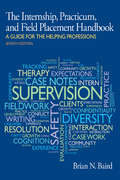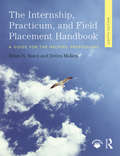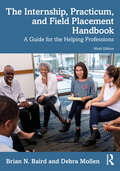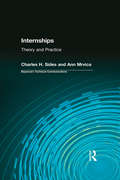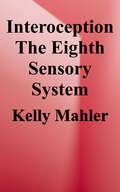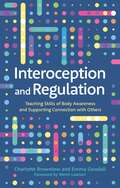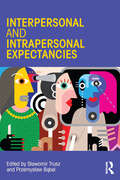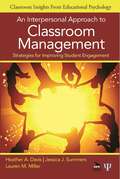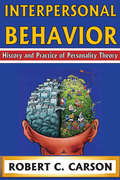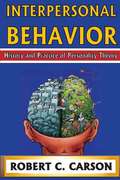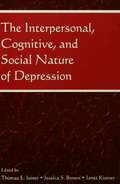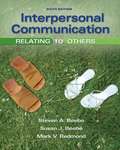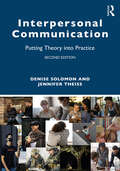- Table View
- List View
Internet and Emotions (Routledge Studies in Science, Technology and Society #22)
by Tova Benski and Eran FisherNothing seems more far removed from the visceral, bodily experience of emotions than the cold, rational technology of the Internet. But as this collection shows, the internet and emotions intersect in interesting and surprising ways. Internet and Emotions is the fruit of an interdisciplinary collaboration of scholars from the sociology of emotions and communication and media studies. It features theoretical and empirical chapters from international researchers who investigate a wide range of issues concerning the sociology of emotions in the context of new media. The book fills a substantial gap in the social research of digital technology, and examines whether the internet invokes emotional states differently from other media and unmediated situations, how emotions are mobilized and internalized into online practices, and how the social definitions of emotions are changing with the emergence of the internet. It explores a wide range of behaviors and emotions from love to mourning, anger, resentment and sadness. What happens to our emotional life in a mediated, disembodied environment, without the bodily element of physical co-presence to set off emotional exchanges? Are there qualitatively new kinds of emotional exchanges taking place on the internet? These are only some of the questions explored in the chapters of this book, with quite surprising answers.
Internet Dating: Intimacy and Social Change (Routledge Advances in Sociology)
by Chris Beasley Mary HolmesInternet Dating deals primarily with the experiences of UK and Australian daters, examining their online accounts to see what kinds of narratives, norms, emotions and ‘chemistry’ shape their dating. Has the emergence and growth of internet dating changed the dating landscape for the better? Most commentators, popular and academic, ask whether online dating is more efficient for individuals than offline dating. We prefer a socio-political perspective. In particular, the book illustrates the extent to which internet dating can advance gender and sexual equality. Drawing on the voices of internet daters themselves, we show that internet dating reveals how social change often arises in the unassuming, everyday and familiar. We also pay attention to often ignored older daters and include consideration of daters in Africa, Scandinavia, South America, Asia and the Middle East. Throughout, we explore the pitfalls and pleasures of men and women daters navigating unconventional directions towards more equitable social relations.
The Internet Family: Technology in Couple and Family Relationships
by Katherine M. Hertlein Markie L. TwistIn The Internet Family, Drs. Katherine Hertlein and Markie Twist provide a current and comprehensive look at the effects of technology on couple and family relationships. Beginning with an overview of the multifaceted ways in which technology impacts our relationships today, the authors discuss a wide range of topics pertinent to couple and family life. Chapters focus on issues such as online dating and infidelity, parenting and the Internet, video gaming, cyberbullying, and everyday usage of social and new media, before providing guidance on how the reader can successfully navigate the advantages and risks that emerge from the use of specific technologies. An online appendix offers a range of assessments and practical tools for identifying Internet-related problems and solutions. A portion of the text is also devoted to the application of the Couple and Family Technology framework and how it can be effectively integrated into clinicians’ current practice. Couple and family therapists will find this book highly informative, both to use in their own practice and for referring clients to as part of the treatment process.
Internet Gambling
by Sally GainsburyInternet gambling is one of the fastest growing forms of gambling. Global Internet gambling expenditure is predicted to reach US$33.6 billion in 2011. This is higher than worldwide movie box office revenues and represents 9% of the international gambling market. The rapid increase in expenditure of 354% since 2003 has occurred despite Internet gambling being prohibited in several key markets, including the US and China. It also suggests that current regulation may be somewhat outdated and ineffective as more and more people turn to this mode of gambling. Internet gambling is highly accessible with over 2,400 sites available 24/7 through computers, mobile phones, wireless devices and even interactive televisions. Gamblers can now play casino games, bingo, cards and poker, bet on races, sports and even celebrity weddings using over 199 means of electronic payments without leaving the house. Increasing international jurisdictions are legalizing Internet gambling and the constant accessibility of online gambling has critical social implications. Gambling operators are using aggressive advertising campaigns to move into new markets. Internet gambling appears to be particularly appealing to youth, who are gambling online at substantially higher rates than adults. Furthermore, Internet gambling appears to be related to problem gambling, with rates of problem gambling three to four times higher among Internet than non-Internet gamblers, indicating that it may have a substantial social cost. The anonymity of online sports betting poses a significant threat to the integrity of sport at all levels with increasing allegations of match-fixing and cheating. Estimates suggested that 50% of all bets on the 2010 FIFA World Cup were placed online, worth an estimated £500 million. These figures represent a 700% rise in online betting since the 2006 tournament and included many new players that opened online accounts. It is essential that appropriate responses are made by governments, industry professionals and the public in response to Internet gambling. This book will provide a comprehensive and up-to-date overview of Internet gambling, including the social impact and regulatory options. A global outline will include the characteristics and features of the many forms of Internet gambling, including the current market, and participation, and differences between Internet and non-Internet gambling. Specific regional considerations will be explored including regulatory responses and options. Importantly, the social consequences and costs of Internet gambling will be examined, including the impact of online gambling on sports, youth and problem gambling. Strategies for prevention and responsible gambling will be considered as well as expected trends.
Internet of Things and Its Applications (EAI/Springer Innovations in Communication and Computing)
by Sachi Nandan Mohanty Jyotir Moy Chatterjee Suneeta SatpathyThis book offers a holistic approach to the Internet of Things (IoT) model, covering both the technologies and their applications, focusing on uniquely identifiable objects and their virtual representations in an Internet-like structure. The authors add to the rapid growth in research on IoT communications and networks, confirming the scalability and broad reach of the core concepts. The book is filled with examples of innovative applications and real-world case studies. The authors also address the business, social, and legal aspects of the Internet of Things and explore the critical topics of security and privacy and their challenges for both individuals and organizations. The contributions are from international experts in academia, industry, and research.
Internet Psychology: The Basics
by Yair Amichai-HamburgerWe can't imagine our lives without the Internet. It is the tool of our existence; without it we couldn't work, plan our social and leisure activities, and interact with friends. The Internet’s influence on contemporary society extends across every aspect of our personal and professional lives, but how has this altered us in psychological terms? How are we to understand how the Internet can promote enormous amounts of caring and kindness to strangers and yet be the source of unremitting acts of terror? This book, grounded in the latest cutting-edge research, enhances our understanding of how we, and our children, behave online. It explores questions such as: Why does our self-control abandon us sometimes on the Internet? Why does the Internet create a separate realm of social and personal relationships? How does all that change us as people? Are youngsters really as exposed and threatened on the web as people think? Internet Psychology: The Basics is a vital and fascinating guide to the online world, drawing on classic theories of human behaviour to shed fresh light on this central facet of modern life. It argues that, even in an age of constant technological advancement, our understanding of the human psyche remains rooted in these well-established theories. Embracing both positive and negative aspects of Internet use, this easy introduction to the subject will appeal to students and general readers alike.
The Internet Trap: Five Costs of Living Online
by Ashesh MukherjeeWhether we are checking emails, following friends on Facebook and Twitter, catching up on gossip from TMZ, planning holidays on TripAdvisor, arranging dates on Match.com, watching videos on Youtube, or simply browsing for deals on Amazon, the internet pervades our professional and personal environments. The internet has revolutionized our lives, but at what cost?In The Internet Trap, Ashesh Mukherjee uses the latest research in consumer psychology to highlight five hidden costs of living online: too many temptations, too much information, too much customization, too many comparisons, and too little privacy. The book uses everyday examples to explain these costs including how surfing the internet anonymously can encourage bad behavior, using social media can make us envious and unhappy, and doing online research can devalue the product finally chosen. The book also provides actionable solutions to minimize these costs. For example, the book reveals how deciding not to choose is as important as deciding what to choose, setting up structural barriers to temptation can reduce overspending on e-commerce websites, and comparisons with others on social media websites needs to be cold rather than hot. The Internet Trap provides a new perspective on the dark side of the internet, and gives readers the tools to become smarter users of the internet.
Internetsucht: Wie man sie erkennt und was man dagegen tun kann (essentials)
by Kai W. MüllerKai W. Müller erläutert in diesem essential Hintergründe rund um das Phänomen der Internetsucht. Auf übersichtliche Art und Weise wird erklärt, was man unter Internetsucht versteht, welche Erkennungsmerkmale herangezogen werden, wie verbreitet dieses noch junge psychische Krankheitsbild ist und welche Hilfsangebote zur Verfügung stehen. Der Leser erhält zudem einen umfassenden Einblick in mögliche Ursachen für die Entstehung dieser Suchtproblematik.
The Internship, Practicum, and Field Placement Handbook: A Guide for the Helping Professions (3rd edition)
by Brian N. BairdStudents, instructors, and field supervisors in the helping professions can use this book as a resource on performing responsibly and safely in field placements. Ethical and legal principles, record keeping, report writing, supervision, diversity, and dealing with dangerous clients are covered in detail in an accessible style. Appendices provide forms for field learning agreements, evaluation, and informed consent. This third edition adds new exercises and incorporates new discussions of managed care, student portfolios, and career planning.
The Internship, Practicum, and Field Placement Handbook
by Brian N. BairdThe Internship, Practicum, and Field Placement Handbook, Seventh Edition is a practical guide to the real world knowledge and skills that students need when they begin working in the field of mental health. This text guides interns through every phase of the internship process from finding placements to concluding relationships with clients and supervisors. Along the way students learn about ethics, clinical writing and record keeping, working with peers and supervisors, understanding diversity, and self care and safety. Following an evidence and competency based approach, the latest research findings are reviewed from the fields of psychology, social work and counseling. "
Internship, Practicum, and Field Placement Handbook: A Guide for the Helping Professions
by Brian N. Baird Debra MollenThe Internship, Practicum, and Field Placement Handbook is a practical guide for interns in the helping professions, with real-world knowledge of the skills students need through every phase of their practicum, field placement, or internship. This text expertly guides students through the essential skills needed for beginning work in the field of mental health and outlines skills that will serve students throughout their academic and professional careers. Skills discussed include how to make a great first impression, understanding the process and content of clinical writing, recordkeeping, working with peers and supervisors, understanding diversity, cultivating self-care, and promoting safety. Every phase of the internship is discussed chronologically: from finding and preparing for placements to concluding relationships with clients and supervisors. Following an evidence and competency-based approach, the latest research findings are reviewed from the fields of psychology, social work, and counseling. The Internship, Practicum, and Field Placement Handbook is an invaluable resource for students, faculty, and supervisors engaged in the exciting, challenging experience of transitioning from academia into clinical training in the field. Free online resources available at www.routledge.com/9781138478701 support the text.
The Internship, Practicum, and Field Placement Handbook: A Guide for the Helping Professions
by Brian N. Baird Debra MollenThe Internship, Practicum, and Field Placement Handbook offers real-world knowledge of the skills interns in the helping professions need through every phase of their internship, practicum, or field placement. The focus is on topics that may not have been addressed or fully developed through regular academic coursework: meeting clients, fees for service, supervision, ethics, legal issues, diversity, clinical writing, case notes and clinical records, personal safety, self-care, advocacy, technology, termination, and planning for the future. Every phase of the internship is discussed sequentially, from finding and preparing for placements to concluding relationships with clients and supervisors. Drawing from the fields of psychology, counseling, social work, school counseling, and psychiatry, this edition has been thoroughly updated with the latest research and clinical literature, ethical codes of the leading professions, and legal and regulatory developments at federal and state levels. This edition also features up-to-date coverage of remote education, training, supervision, and practice as impacted by Covid-19 and technological changes. Diversity awareness and insights are woven through every element of the text, taking into account recent developments such as Black Lives Matter, the MeToo movement, gender identity awareness. Other emerging issues are also addressed, including the impact of the opioid epidemic and substance abuse deaths and the ethical/legal issues that may arise relating to reproductive health and abortion related legislation. In-text exercises and thought problems are incorporated into each chapter for students to develop insights and skills. Eleven online appendices are also included, containing learning plans, supervision agreements, evaluation forms, and ethical guidelines that students will need in preparation for the next phase of their training. The Internship, Practicum, and Field Placement Handbook is an invaluable resource for students, faculty, and supervisors engaged in the challenging experience of transitioning from academia into clinical training in the field.
Internships: Theory and Practice (Baywood's Technical Communications)
by Charles Sides Ann Mrvica"Internships: Theory and Practice" focuses on the history, theory, value, design, administration, and evaluation of professional internships as an educational experience for college students. Internships are guided, pre-professional experiences that combine academic and professional components as a managed transition to professional careers. Touted by many as an educational innovation for the 21st century, internships (or experiential learning, or apprenticeships, as they once were called) have been a staple of professional preparation for centuries, dating back at least to the earliest documentation in the Middle Ages and no doubt far beyond that.Charles Sides and Ann Mrvica trace this history through primary sources to explore the development of internship experiences over the past 800 years, create an introduction to the topic of internships, and provide a foundation for modern college-corporation partnerships in professional education and training. The authors present specific guidelines and discussions on issues important to corporations, in terms of providing for internship experiences; issues important to colleges, in terms of designing and evaluating internships; and issues important to students, in terms of participating in and learning from internships.
Interoception: The Eighth Sensory System
by Kelly MahlerInteroception, a newly identified eighth sense, allows us to "feel our internal organs and skin and gives information regarding the internal state or condition of our body." As such it is also a key component of our emotional experience. This is an area of difficulty for many, including those with autism spectrum disorders. <p><p>The book reviews the research underlying the effects of poor interoception and outlines strategies for how to ameliorate these effects.--Publisher
Interoception and Regulation: Teaching Skills of Body Awareness and Supporting Connection with Others
by Emma Goodall Charlotte BrownlowThere are some things that many of us take for granted - such as knowing when we are hot or cold, feel hungry, or need to go to the toilet. But how do we know these things, and why do some people struggle to recognise them? Interoception - the ability to identify and act on physical sensations inside the body - is crucial to human well-being. It underpins physical developmental milestones, such as toilet-training, as well emotional ones, such as the ability to self-regulate. Research shows that Autism often co-occurs with poor interoceptive sense.This practical and informative book demystifies interoception and provides tools to help boost interoceptive abilities. It summarises the latest research, explores how interoceptive difficulties can be identified, suggests strategies to manage feelings and emotions, and explains how to support individuals in 'tuning in' to themselves.
Interorganisationale kollaborative Gemeinschaftsforschung: Forschungscampus für den Automobilbau der Zukunft: ARENA2036 (ARENA2036)
by Roeland HoogeveenWie verhalten sich Spitzenkräfte aus Universität, Forschungseinrichtungen und Industrie unter einem Dach? Wie entstehen Ideen, was fördert die Kreativität, wie bringt man die Ergebnisse schnell aus der Forschungsfabrik in die industrielle Produktion? Diese und angrenzende Fragen werden in diesem Forschungsbericht beantwortet.Im Querschnittsbereich der ARENA2036 wurde die spezielle Arbeitsumgebung – die Forschungsfabrik – arbeitswissenschaftlich fundiert ausgestaltet. In diesem Buch werden die resultierenden Analysen und Reflexion vorgestellt. Ferner werden Methoden dargestellt, um die Technologie- und Produktentwicklung besser aufeinander abzustimmen. Ergebnisse zur interdisziplinäre Zusammenarbeit innerhalb der ARENA2036 werden diskutiert und daraus ein Ansatz zur beschleunigten Verbreitung der benötigten Kompetenzen entwickelt, die zur Nutzung grundlegend neuer Technologien benötigt werden.
Interpersonal and Intrapersonal Expectancies
by Sławomir Trusz Przemysław BąbelDo our expectancies about ourselves and about others have any effect on our actual experiences? Over fifty years of research studies suggest not only that this is the case, but also that our expectancies can shape other people’s experience in different contexts. In some cases they can help, but other times they can do harm instead. Interpersonal and Intrapersonal Expectancies provides a theory, a research review, and a summary of the current knowledge on intra- and interpersonal expectancy effects and related phenomena. Based on extensive study, and written by eminent experts from some of the world’s leading academic institutions, the book presents the most recent knowledge on social and psychological mechanisms of forming both intra- and interpersonal expectancies. It also considers how expectancies are sustained and what their consequences are, as well as discussing the latest theoretical concepts and the most up-to-date research on expectancy effects. This book represents the first review of the phenomenon of interpersonal expectancies in over 20 years, and the only publication presenting a complementary view of both intra- and interpersonal expectancies. It aims to open up a discussion between researchers and theoreticians from both perspectives, and to promote an integrative approach that incorporates both.
An Interpersonal Approach to Classroom Management: Strategies for Improving Student Engagement
by Heather A. Davis Jessica J. Summers Lauren M. MillerThe authors engage you from the start by contrasting how differently teachers respond to common situations. They expertly bridge the gap between educational psychology and classroom management from the perspectives of student engagement, peer and student-teacher relationships, and teacher self regulation. Both current and prospective teachers will find helpful tools for engaging difficult students, managing challenging relationships, and handling conflict. Key topics include: <p><p> Student behavioral, relational, and cognitive engagement in the learning process <p> Classroom structures that contribute to student engagement <p> The contribution of peer relationships to positive and negative behavior management <p> Strategies that help children learn to manage their own behavior <p> Connecting with students who are culturally and linguistically diverse
Interpersonal Argumentation in Educational and Professional Contexts
by Francesco Arcidiacono Antonio BovaThis book provides a comprehensive overview of empirical studies based on various approaches devoted to examining the interpersonal argumentative processes involved in different contexts. It also identifies context-dependent similarities and differences in the ways in which argumentative interactions are managed by individuals in a range of educational and professional settings. How can some forms of negotiation, change and debate result from engaging in interpersonal processes during argumentation? How do interpersonal dimensions affect the interdependencies between argumentative exchanges and construction of knowledge and skills? The book clarifies these open questions by providing a discussion of theoretical and empirical issues at the forefront of research, in order to provide a view of how interpersonal argumentation in educational and professional contexts is actually questioned and investigated. It offers readers an opportunity to discover the crucial importance of an in-depth understanding of the role and functions played by the interpersonal dynamics within argumentative interactions occurring in a wide range of educational and professional contexts.
Interpersonal Behavior: History and Practice of Personality Theory
by Robert CarsonThis book represents an inquiry into an area of human behavior at once fascinating and exasperating. It is fascinating because it is a class of behavior that, while peculiarly resistant to cognitive analysis and clarification it remains, for most of us throughout our lives, a subjectively crucial issue. In Interpersonal Behavior Carson analyzes, describes, and explains the transactions that occur between persons. The analysis focuses upon the smallest possible unit of social interaction, the dyad, or two-person group.This book is as important today as when it first appeared in 1969 because it forces us to recognize that attributions to others are incomplete without reference to the circumstances in which a particular behavior occurs. Carson posits that, while personality characteristics may not be ephemeral, any observed stability is the product of whatever propensities can accurately be identified as existing "inside" the person, and the interpersonal situation in which they are expressed. Carson urges us to examine more carefully the effect of noncomplementarity on what appears to be stable personality characteristics.Carson introduces us to the principal interpersonal theorists in a series of expository chapters that are both lucid and authoritative. His long experience as a clinical psychologist enables him to make a telling application of interaction concepts of personality to the field of mental and emotional "illness." He makes clear that many people designated as "mental patients" have suffered real harm because they are perceived as having a "diseased" personality, rather than as people who, under certain circumstances, behave deviantly.
Interpersonal Behavior: History and Practice of Personality Theory
by Robert C. CarsonCarson posits that, while personality characteristics may not be ephemeral, any observed stability is the product of whatever propensities can accurately be identified as existing "inside" the person, and the interpersonal situation in which they are expressed. Carson urges us to examine more carefully the effect of non complementarity on what appears to be stable personality characteristics.
The Interpersonal, Cognitive, and Social Nature of Depression
by Thomas E. Joiner Jessica S. Brown Janet KistnerThe true integration of interpersonal, social psychology, and cognitive-behavioral approaches is the most important theoretical issue in the field of the psychology of depression, and yet it has not been well addressed in any forum. The Interpersonal, Cognitive, and Social Nature of Depression was written to provide cutting-edge research and theoretical perspectives on this issue. Its goal is to concretize and celebrate an integrative approach to the understanding of depression, and to foster its sequelae, by bringing together primary figures from interpersonal, cognitive, and behavioral viewpoints for state-of-the-art treatment of the psychology of depression. In addition, this book provides:* an integration of these perspectives on depression research to help guide researchers in developing projects;* up-to-date research findings to help researchers update their knowledge of depression research;* a detailed review of studies evaluating the effectiveness of cognitive therapy for treatment and prevention of depression;* focused chapters on issues related to depression in childhood and adolescence; and* chapters presenting research focusing on both the manic and depressed phases of bipolar disorder. This text will appeal to a diverse audience from several sources: clinical practitioners, sociology, psychology, psychiatry, researchers, and graduate students in these fields.
Interpersonal Communication: Relating to Others
by Steven A. Beebe Susan J. Beebe Mark V. RedmondRecognized for its focus on being "other-oriented" - a focal point that highlights the importance interpersonal interactions -Interpersonal Communication: Relating to Others enhances communication competence in a variety of interpersonal relationships and interpersonal contexts. This sixth edition emphasizes the expanding role of technology in interpersonal communication and the implication of its use in our daily relationships and communication with others. Relating to Others also offers exceptional coverage of cultural diversity, to help readers understand and adapt to these differences while learning how to establish common links with other individuals enabling them to build and strengthen relationships in their everyday lives.
Interpersonal Communication: Putting Theory into Practice
by Denise Solomon Jennifer TheissThis fully revised text demystifies interpersonal communication skills by bringing the latest research together with practical guidance that prepares students to discern key communication dynamics and communicate more effectively in all areas of their lives. The new edition draws on current theory and research to guide students through the foundations of the discipline, recent developments in scientific research, and tips for improving their own interpersonal communication skills. In addition, readers will find: Expanded coverage of technology and computer-mediated communication, including explicit examples of what interpersonal communication looks like online. Invitations to engage with elaborated descriptions of theories and related resources on the companion website whenever prominent theories of interpersonal communication are mentioned in the text. A commitment to gender inclusive language and topics, as well as a new feature, "IDEA: Inclusion, Diversity, Equity, and Access," that invites students to consider ways to address exclusion and inequity in interpersonal communication. The fully revamped companion website includes updates across all resources, additional videos, self-quizzes for students, and all-new instructor resources, which can be accessed at www.routledge.com/cw/solomon. Also new to the companion website for this edition are links to essays and videos featuring the work that students in the Communication Studies program at the California State Prison, Los Angeles County, produced in response to self-reflection prompts in the first edition. These materials provide insight into facets of interpersonal communication in these students’ lives, and they offer a broad range of rich life experiences. Interpersonal Communication: Putting Theory Into Practice, Second Edition is ideal for undergraduate students in courses on interpersonal communication and communication skills.
Interpersonal Communication and Human Relationships
by Mark L. Knapp Anita L. Vangelisti John P. CaughlinThis title introduces students to interpersonal communication principles and theories through the use of commonplace experiences, such as relationships with roommates, friends and co-workers. The book aims to motivate students to critically think about their own relational communication; it also peaks student interest in social science research. <p><p>MySearchLab is a part of the Knapp/Vangelisti/Caughlin program. Research and writing tools, including access to academic journals, help students explore human communication in even greater depth.
